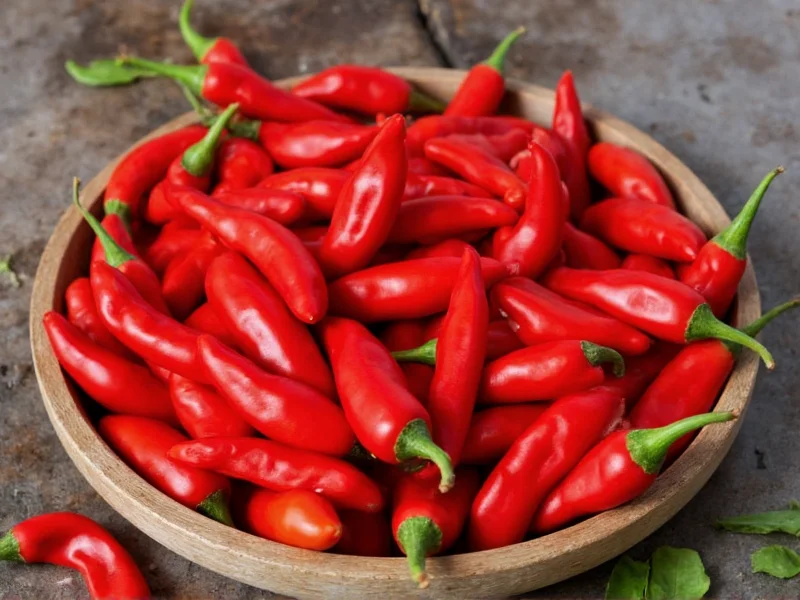Fresno chiles represent one of the most versatile medium-heat peppers in culinary applications, yet many home cooks remain uncertain about their precise heat level. Understanding the fresno chile scoville rating provides essential context for proper usage in recipes and helps prevent unexpected spiciness in dishes. Unlike the common misconception that all red chilies are extremely hot, Fresno peppers offer a manageable heat that enhances rather than overwhelms flavors.
Understanding the Scoville Scale Context
The Scoville scale measures chili pepper pungency through Scoville Heat Units (SHU), which quantify the concentration of capsaicinoids—the compounds responsible for heat sensation. Developed by pharmacist Wilbur Scoville in 1912, this measurement remains the standard reference for comparing pepper heat levels. When examining fresno pepper scoville units, it's crucial to recognize that heat can vary significantly based on growing conditions, maturity, and even individual pepper characteristics.
Fresno Chile Heat Level Comparison
Positioned between mild and hot peppers, Fresno chiles serve as an excellent transition chili for those developing their spice tolerance. Their heat profile makes them particularly valuable in dishes requiring noticeable but not overwhelming spiciness. The following comparison illustrates where Fresno chiles sit within the broader pepper spectrum:
| Pepper Variety | Scoville Heat Units (SHU) | Heat Level |
|---|---|---|
| Fresno Chile (green) | 2,500-6,000 | Medium |
| Fresno Chile (red, mature) | 5,000-10,000 | Medium-Hot |
| Jalapeño | 2,500-8,000 | Medium |
| Serrano | 10,000-23,000 | Hot |
| Poblano | 1,000-2,000 | Mild |
| Habanero | 100,000-350,000 | Very Hot |
Factors Influencing Fresno Chile Heat
Several variables affect the actual heat experienced when using Fresno chiles, explaining why how hot are fresno chiles can yield different answers:
- Maturity stage: Green Fresnos (harvested early) typically measure 2,500-6,000 SHU, while fully ripened red Fresnos reach 5,000-10,000 SHU
- Growing conditions: Stress factors like water scarcity or temperature extremes increase capsaicin production
- Plant genetics: Different cultivars produce varying heat levels even under identical conditions
- Preparation method: Removing seeds and membranes significantly reduces perceived heat
Culinary Applications Based on Heat Level
The fresno chile heat level comparison to other peppers informs smart culinary decisions. Chefs value Fresnos for their balanced heat that complements rather than dominates dishes. Their thinner walls compared to jalapeños make them particularly suitable for:
- Fresh salsas and pico de gallo where texture matters
- Vinegar-based hot sauces requiring clear pepper flavor
- Garnishes for soups and stews where visual appeal is important
- Infused oils where moderate heat transfers effectively
When substituting Fresnos in recipes, remember that red Fresnos deliver noticeably more heat than their green counterparts. For those asking fresno chile vs jalapeno heat, note that while their ranges overlap, Fresnos generally provide a fruitier flavor profile with slightly less intense heat than comparable jalapeños.
Practical Cooking Tips for Managing Heat
Understanding the precise fresno chile scoville rating helps home cooks control spiciness effectively:
- Taste before using: Sample a small piece of the specific pepper you're working with, as heat varies significantly between individual chilies
- Remove membranes: The white pith contains most capsaicin—scraping it out reduces heat by up to 80%
- Balance with dairy: Yogurt, sour cream, or cheese counteracts capsaicin effectively in finished dishes
- Consider cooking time: Prolonged cooking distributes heat more evenly but doesn't reduce overall spiciness
Growing Conditions and Heat Development
For gardeners curious about are fresno chiles hot under different conditions, several factors influence heat production:
Peppers develop more capsaicin when experiencing moderate stress. Gardeners seeking milder Fresnos should maintain consistent watering and optimal temperatures (70-85°F). Those wanting increased heat can introduce controlled stress through slightly reduced watering during fruit development. Soil composition also plays a role—peppers grown in calcium-rich soil often produce milder fruit.
Common Misconceptions About Fresno Heat
Several myths persist about Fresno chile heat levels that deserve clarification:
- Color equals heat: While red Fresnos are generally hotter than green, color alone doesn't determine heat—some green specimens can exceed red ones
- Size indicates spiciness: Smaller peppers aren't necessarily hotter; heat depends more on genetics and growing conditions
- All Fresnos taste identical: Regional variations and cultivation methods create significant flavor differences beyond just heat level
Understanding these nuances helps cooks make informed decisions when selecting peppers for specific recipes. The fresno chile scoville scale position provides valuable context, but practical experience with individual peppers remains essential for perfect seasoning.











 浙公网安备
33010002000092号
浙公网安备
33010002000092号 浙B2-20120091-4
浙B2-20120091-4